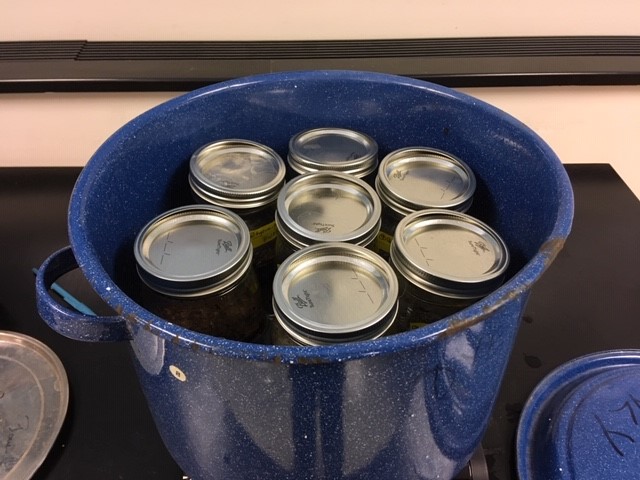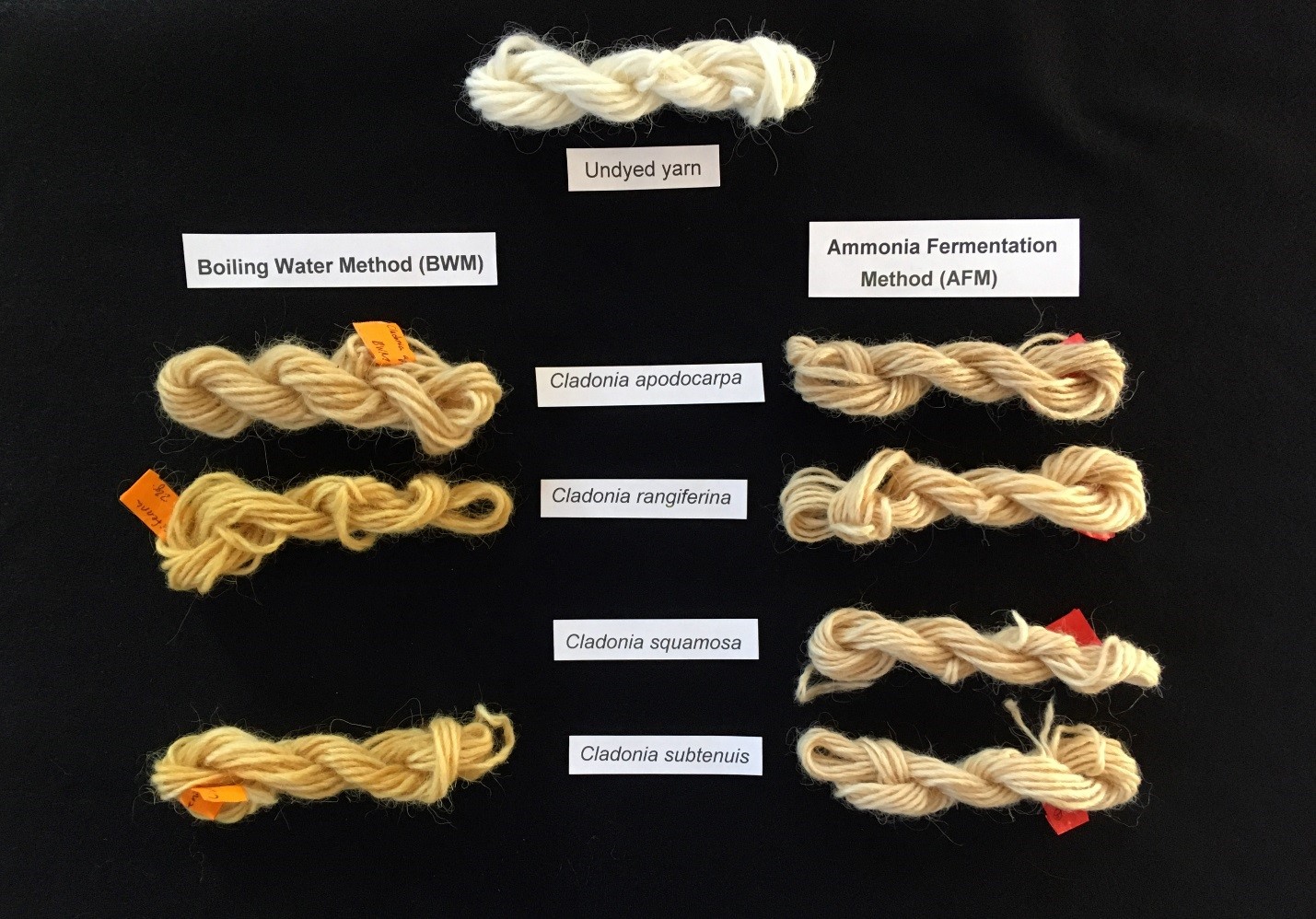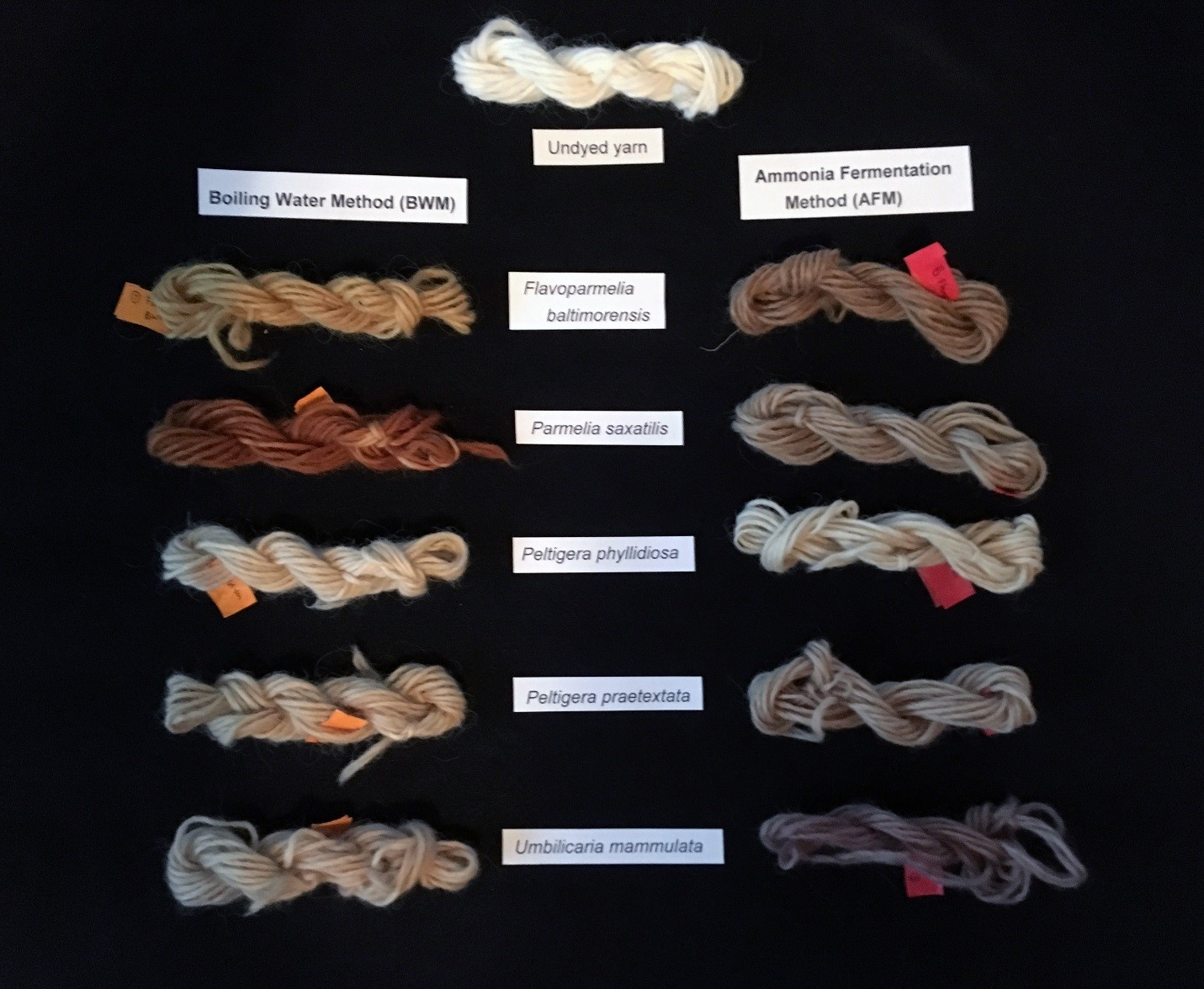Lichens to Dye For: Testing Lichen Species for Dye Colors
Deane Bowers, Erin Tripp and James Lendemer
Introduction
Lichens can be wonderful for dyeing, and their use as dyes has been important for centuries. The colors from lichens are generally due to the presence of chemical compounds called lichen acids. Some of these chemicals may produce the pigment without special treatment and can be extracted in hot water; others must be fermented with ammonia or, in earlier times, urine, in order for the pigment compounds to develop. As part of a new course in Lichenology taught at the University of Colorado, Boulder, we developed an experimental lab on lichen dyeing, using a set of nine different lichen species (Table 1). Our goal was to compare the colors resulting from using the two different preparation methods that are traditionally used for lichen dyeing: boiling water bath (BWM) or ammonia fermentation (AMF), on the same set of lichens.
The lichens used in this laboratory exercise were collected as part of lichen biodiversity inventories carried out by Tripp and colleagues in Tennessee and Colorado in 2018 (Table 1). Specimens from the field were identified by Tripp and Lendemer and then used in the laboratory experiment. Specimens were identified either using regional keys (Lendemer, et al. 2013; Tripp and Lendemer, in press) or unpublished, working knowledge of the biota. Voucher data are available in COLO’s internal database (https://botanydb.colorado.edu/index.php), and are also available on SEINet [http://swbiodiversity.org/seinet/]) and iDigBio (https://www.idigbio.org/).
| Lichen Species | Source | Weight extracted for each preparation method (both BWM and AFM) | Color predicted from data and compounds | Reference | Compounds that may produce colors |
| Cladonia rangiferina (L.) F.H. Wigg. | Tennessee | 15g | Yellow (BWM) Maybe pink with AFM | Based on other Cladonia species in Ref. 1 | Atranorin, fumarprotocetraric acid |
| Cladonia subtenuus (Abbayes) Mattick | Tennessee | 15g | Yellow (BWM) Maybe pink with AFM | ditto | Usnic acid, fumarprotocetraric acid |
| Cladonia squamosa (Scop.) Hoffm. | Tennessee | 15g | Yellow (BWM) Maybe pink with AFM | ditto | Squamatic acid |
| Cladonia apodocarpa Robbins | Tennessee | 20g | Yellow (BWM) Maybe pink with AFM | ditto | Atranorin, fumarprotocetraric acid |
| Peltigera phyllidiosa Goffinet & Miadl. | Tennessee | 10g | Yellow to tan (BWM) Maybe pink-purple with AFM | Based on other Peltigera species in Ref. 1 | tenuiorin, methyl gyrophorate, gyrophoric acid, zeorin, unidentified compound |
| Peltigera praetextata (Flörke ex Sommerf.) Zopf | Tennessee | 10g | Yellow to tan (BWM) Maybe pink-purple with AFM | ditto | No known compounds that might give color |
| Parmelia saxatilis (L.) Ach. | Colorado | 10g | Yellow or rust with BWM; pink with AFM | Ref. 1 and many others | Atranorin, salazinic acid, chloroatranorin |
| Flavoparmelia baltimorensis (Gyeln. & Fóriss.) Hale | Tennessee | 15g | Yellow with BWM, based on presence of usnic acid. | No references found | Usnic acid, protocetraric acid |
| Umbilicaria mammulata (Ach.) Tuck. | Tennessee | 15g | Brown with BWM (Ref. 1). Purple with AMF (Ref. 2) | Ref. 1 and 2 | Gyrophoric acid |
Ref. 1 = Casselman (2001); Ref. 2 = Allen (2014)
Only lichens that were common at the field sites were used in the study. Depending on the amounts of the different lichen species that were available, we used set amounts for the extractions and dyeing. Voucher specimens are deposited at the University of Colorado Herbarium (COLO). Two of the species used are well-known for producing strong colors: Parmelia saxatilis (L.) Ach., known to produce colors from yellow to orange to rust with boiling water extraction (Casselman 2001); and Umbilicaria mammulata (Ach.) Tuck., known to produce purple with ammonia extraction (Allen 2014).
Lichen Conservation
Many lichens are long-lived and slow-growing. As a result, removal of large amounts of lichen can be detrimental to the population. At the same time, there are opportunities to harvest lichens from sources that are not detrimental. For example, collection of lichens from fallen branches or branches resulting from pruning, or pieces of lichen that are removed from their substrate by wind or storms, have fewer environmental impacts; such collections are typically referred to as “found” lichens. Graveyards or other human establishments (rooftops, city buildings, etc.) can also be good places to collect lichens. Many cemeteries periodically clean the tombstones of lichens, since over the long-term, lichens can damage the stones; thus these may be good collecting places.
Karen Casselman (2001, pages 47-48) and her colleagues have developed a code of ethics for collecting lichens. She suggests the following as guidelines for lichen collecting (paraphrased from Casselman 2001, pages 51-52):
In addition, Casselman has several suggestions for optimizing use of lichens for dyeing. For example, use lichens as a dye for smaller projects rather than large ones. In addition, multiple extractions of the same mass of lichens can produce a larger amount of dye.
Methods
Fermentation treatment. For each species, 10 to 20 grams (depending on the amount of lichen available) were put into half-gallon or quart canning jars (Figures 1 and 2) on April 16, 2018. 500 milliliters of distilled water and 250 milliliters of ammonia were added to each jar. Jars were left at room temperature and shaken several times each day and lids removed occasionally to allow aeration. Although many resources suggest fermentation times of three to six months (e.g., Casselman, 2001), because the laboratory exercise was on May 15, these samples were fermented for only one month.


For the dyeing, 200 milliliters were taken from each extraction and put into 1 quart canning jars. 300 milliliters of distilled water was added to each for a total of 500 milliliters for each dye bath.
Boiling water treatment. For each species, the same amount used for the fermentation treatments was weighed out, put into quart canning jars, and 500 milliliters of distilled water was added.
All jars were then placed in large pots of water and the pots were heated (Figure 3) to simmering. One small skein of Icelandic Lopi wool yarn (4 - 5 grams, color Natural) was placed into each jar. In addition, to examine how the different species and extraction methods dyed other fibers, small squares (6 - 9 inches) of wool fabric, silk fabric, and cotton fabric were added to the jars. Not all jars received the same fabrics; however, all jars did receive the yarn skeins. All jars were simmered for one hour.

Fiber preparation. Although many resources say that fiber to be dyed with lichen does not require any pre-mordant, some do suggest an alum and tartaric acid pre-mordant. The Lopi yarn was pre-mordanted in 10% weight of goods (WOG) alum and 2% WOG tartaric acid. The wool fabric and cotton and silk fabrics were not pre-mordanted.
Results and Discussion
A variety of different colors were obtained (Figures 4 and 5). As expected from the literature, Parmelia saxatilis gave a beautiful rust color with the BWM, but yielded a tan color with the AFM (Figure 5). Umbilicaria mammulata with AFM gave a purple, but compared to illustrations of the purple possible from this lichen (e.g., Allen 2014), the purple was more brownish (Figure 5). The Cladonia species gave beautiful yellows, from both the BWM and the AFM. Casselman (2001) lists several Cladonia species that can produce colors ranging from light green to yellow to gold to rust. Our four species all gave yellows (Figure 4).


This laboratory exercise helped students understand the chemical compounds in lichens that produce dyes and how the two different methods, AFM and BWM, can produce very different colors. It also allowed them to appreciate one of the many uses of lichens by humans. The amounts of the different lichens used were relatively small, only 30 – 40 grams and thus such an exercise should not make a heavy impact on local lichen populations. This laboratory exercise would be suitable for courses or laboratory exercises on topics such as lichenology, mycology, fiber arts, and natural dyes. Additional information about this exercise can be obtained by contacting the authors.
Acknowlegdements
The authors are grateful to the following sources that supported the development and teaching of this new course, The Lichen Biome, was supported by 1) a grant from the National Science Foundation (NSF Dimensions of Biodiversity Program, Awards #1542629 & #1432629 to ET and JL), 2) a Course Development Grant from the University of Colorado’s Faculty Teaching Excellence Program, and 3) the Department of Ecology and Evolutionary Biology at the University of Colorado.
References
Allen, A., 2014. Getting started with lichen dyes. Fungi 7:66-69.
Brodo, I.M., S.D. Sharnoff and S. Sharnoff, 2001. Lichens of North America. New Haven, CT: Yale University Press.
Casselman, K., 2001. Lichen Dyes: The New Source Book. Dover Publications, Inc.
Casselman, K., 1993. The Craft of the Dyer: Colour from Plants and Lichens. 2nd edition. Dover Publications, Inc.
Fraser, J., 1985. Traditional Scottish Dyes and How to Make Them. Canongate Publishing.
Tripp, E.A. and J.C. Lendemer, In Press. Field Guide to the Lichens of Great Smoky Mountains National Park. Knoxville, TN: University of Tennessee Press.
About the Authors
Deane Bowers is a professor of biology, and the curator of the entomology collection, at the University of Colorado, Boulder. In addition to her research on insect ecology and evolution (including dyeing with insects!), she is an avid natural dyer and fiber enthusiast. Contact: deane.bowers@colorado.edu.
Erin Tripp is a professor of biology, and the curator of the herbarium, at the University of Colorado, Boulder. Her research specialties are the ecology, evolution and taxonomy of lichens and the ecology and evolution of plants in the Acanthus family (Acanthaceae). Contact: erin.tripp@colorado.edu.
James Lendemer is a curator at the Institute of Systematic Botany at the New York Botanical Gardens and a professor of biology at the City University of New York. His research specialty is lichen biodiversity, conservation and systematics. Contact: jlendemer@nybg.org.
 Turkey Red Journal
Turkey Red Journal
